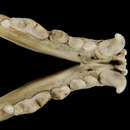en
names in breadcrumbs


Perception Channels: tactile ; chemical
Considered to be North America's rarest mammal. Black-footed ferrets have been heavily impacted by the extermination of prairie dogs. Ranchers poisoned prairie dogs because of destruction (tunneling and foraging) to rangelands. With the disappearance of prairie dogs, so too went black-footed ferrets. Numbers dropped to an astounding 31 in 1985, and by 1987 they were extinct in the wild. Of the original 100 million acres of black-footed ferret habitat, only 2 million acres remain. Many ferrets were also killed by a canine distemper epidemic that spread through the American grasslands.
Captive breeding and reintroduction programs are underway in several locations throughtout North America (Massicot 2000)
US Federal List: endangered
CITES: appendix i
IUCN Red List of Threatened Species: endangered
Black-footed ferrets are often seen as pests by ranchers. The tunnel systems that are used by ferrets and prairie dogs cause holes in the the earth in the grazing lands of cattle. Unfortunate livestock sometimes step into these holes and become lame, after which they must be destroyed.
Black-footed ferrets help control populations of prairie dogs, which are sometimes seen as pests because of their burrowing activities and because they as as reservoirs for zoonotic diseases such as bubonic plaque.
Black-footed ferrets rely primarily on prairie dogs for food. However, they sometimes eat mice, ground squirrels, and other small animals. Normally, over 90% of a black-footed ferret's diet consists of prairie dogs, which are hunted and killed within their burrows. A black-footed ferret typically consumes between 50-70 grams of meat per day. It has been observed that black-footed ferrets only kill enough to eat, and caches of stored food are not usually found (Massicot 2000, Wilson & Ruff 1999, Nowak 1991, Hillman & Clark 1980).
Historically, Mustela nigripes ranged throughout the interior regions of North America, from southern Canada to northern Mexico. Mustela nigripes is the only ferret that is native to North America. Today, Mustela nigripes exists in the wild in three locations, northeastern Montana, western South Dakota, and southeastern Wyoming. All three locations are sites where they have been reintroduced after the original populations were extirpated. Mustela nigripes populations also exist in seven zoos and breeding facilities (Massicot 2000, Wilson & Ruff 1999, Nowak 1991, Hillman & Clark 1980).
Biogeographic Regions: nearctic (Native )
Black-footed ferrets can be found in the short or middle grass prairies and rolling hills of North America. Each ferret typically needs about 100-120 acres of space upon which to forage for food. They live within the abandoned burrows of prairie dogs and use these complex underground tunnels for shelter and hunting. A mother with a litter of three would need approximately 140 acres to survive (Massicot 2000, Nowak 1991).
Terrestrial Biomes: savanna or grassland
Average lifespan
Status: captivity: 12.0 years.
Female black-footed ferrets range in weight from 645 to 850 grams, while the weight of males ranges from 915 to 1,125grams. Mustela nigripes ranges in length from 380 to 600mm (head and body). In linear measurements, male black-footed ferrets are generally 10% larger than females. The fur of Mustela nigripes is yellowish-buff with pale underparts. The forehead, muzzle, and throat are white; while the feet are black. A black mask is observed around the eyes, which is well defined in young black-footed ferrets (Massicot 2000, Wilson & Ruff 1999, Nowak 1991, Hillman & Clark 1980).
Range mass: 645 to 1125 g.
Other Physical Features: endothermic ; bilateral symmetry
Females become sexually mature at the age of one year. The breeding season typically extends through March and April. The gestation period ranges from 35-45 days. Litters range from 1-6 young, with an average litter size of 3.5 young. Young remain in the burrow for about 42 days before coming aboveground. During the summer months of July and August females and their young stay together, in the fall they separate as the young ferrets reach their independence. Females ferrets have three pairs of mammae. Ferrets are sexually dimorphic, with males being larger than the female. During the mating season, females aggressively solicit males. Black-footed ferrets exhibit a phenomenon known as "delayed implantation," in which the fertilized egg does not start developing until conditions are appropriate for gestation (Massicot 2000, Wilson & Ruff 1999, Nowak 1991, Hillman & Clark 1980).
Key Reproductive Features: gonochoric/gonochoristic/dioecious (sexes separate); sexual
Average gestation period: 43 days.
Average number of offspring: 3.
Average age at sexual or reproductive maturity (male)
Sex: male: 365 days.
Average age at sexual or reproductive maturity (female)
Sex: female: 365 days.